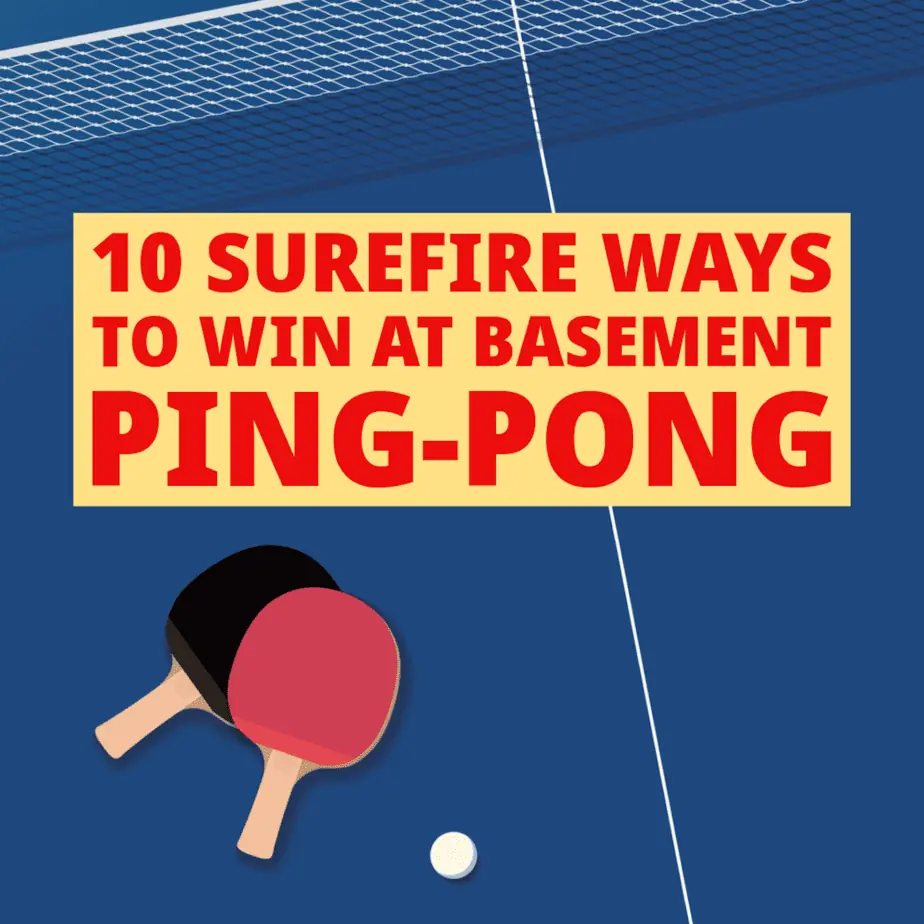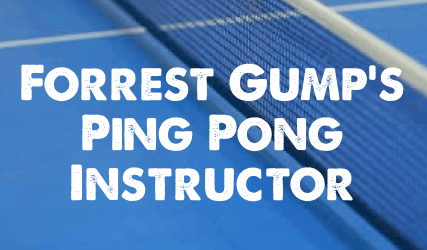Winning consistently at ping-pong requires practice, and it also helps to have a good knowledge of strategy and tactics to win points.
Let’s get the ball bouncing by explaining some table tennis tips that can take an intermediate player to an advanced player.

How to win at basement ping-pong
Here are some tips to help take you to a higher level of play.
1.) Track your opponent’s racquet.
If your opponent’s paddle moves down — which means a backspin is being placed on the ball — you’re more likely to hit the ball down unless you adjust. If your opponent’s racquet moves to your right when he’s putting on a spin, you’re more likely to hit the ball to your right unless you adjust. The key is to zero in on the direction that your opponent’s racquet is moving in and make adjustments accordingly.
2.) Mix up your serves.
Use different lengths, different speeds, and different spins. Be consistent about not missing serves but inconsistent in terms of the type of serve. The service is a big part of the game — don’t just put the ball in play. Put a ball in play that gives you an advantage.
3.) Work on the double-bounce serve.
The double-bounce serves, where the ball bounces twice on the opponent’s side if left alone (with the first bounce being mid-table), is a very effective service in table tennis. It makes it hard for your opponent to return the serve with a powerful return. It also makes it challenging for your opponent to return the serve short and decreases the angles available to your opponent.
4.) Go on the offensive.
As with tennis, this is true at an advanced level where points are usually won. With beginners, it’s estimated that about 80% of points are lost. So, if you’re playing a beginner, just being consistent will win the most points. As you advance and play better points, you must work on winning points and being consistent.
For most players, the forehand is the stroke that allows them to attack the best. Use your footwork to put yourself in a position to hit attacking forehand shots.
5.) Play out every point.
Don’t anticipate that you’ve hit a winner. The ball might just be coming back.
6.) Bend your knees.
An athletic stance helps you use your legs and will make your shots more powerful. You’ll also be better positioned to move and get to more shots.

7.) Master a third ball attack.
After an opponent returns your service, look to finish with a powerful shot. For example, a short serve to an opponent’s forehand will sometimes cause the return to pop up. Be ready to finish.
8.) Identify and exploit your opponent’s weakness.
When warming up, hit several balls right in the middle and determine if your opponent is more comfortable hitting forehands or backhands. If they’re more comfortable hitting forehands, hit to their backhand at critical stages in points. Or continue to hit several shots in a row to your opponent’s weaker side.
If you’ve ever seen Nadal attack Federer’s backhand with his topspin forehand in the game of tennis, you’ve got the idea. Many amateur players have a decided preference as to which side they’d like to hit the ball. Try to figure out which side that is before the match even commences.
9.) Control the center of the table.
In the game of chess, controlling the center of the board gives a player many advantages. As with chess, you’ll want to try to control the center of the table tennis top. If you hit a sharp angle on a shot and move your opponent to one side, upon their return, there may be an opportunity to hit a short shot to the opposite side. In practice, try this technique and practice it.
10.) Hit the ball at its highest point on forehand drives.
Hit the ball at its highest mark gives you the best opportunity to place it over the net. Turn at the waist, and with a closed paddle, finish in front of your body. Focus on consistency first. Increase your arm speed to add power after you’ve mastered consistency.
History of table tennis
Although the game’s origins may go back even further, tennis enthusiasts popularized it by trying to take their favorite sport inside during the Victorian period. They used everyday objects to play. A line of books served as the net, a cigar lid as the paddle, and a rolled-up string for the ball. Soon, entrepreneurial types moved to improve the equipment, and equipment improvements continued to be part of the game.
There have been some significant changes to the game since most baby boomers learned to play. After the 2000 Olympic games, the ball size was increased from 38mm to 40mm. A bigger ball is slower and less receptive to spin. The bigger ball counters some of the increased speed and spin brought on by racquet improvements. Another change: most tournament games are played to 11 points, with players alternating serves every two points. It used to be standard practice to play to 21 points and alternate serves every 5 points.
Table tennis fun facts
A.) At the 1936 World Championships contested in Prague, two defensive players battled for one hour for just one point. The whole match took 4 hours.
B.) Table tennis was banned in the former Soviet Union from 1930 to 1950 because the sport was believed to be harmful to the eyes.
C.) Parker Brothers trademarked the name “Ping-Pong,” thus forever creating confusion over whether to call the game ping-pong or table tennis. Some distinguish that table tennis is a sport and ping-pong is just a basement game. Like most, I’m using the terms interchangeably.
D.) The most popular table tennis grip in recreation and professional play is the shake-hand grip.
One of the great things about the sport of table tennis is that there are so many people who think they’re great at the game. Here are a few tips to work on that should help you beat those people.
Master these tips, and you should be on your way to beat most players. Watch this video to see a classic match-up between an attacker and a defender in table tennis.

By Mike O’Halloran
Founder and Editor, Sports Feel Good Stories
Overtime
You’re on the Surefire Ways to Win at Basement Ping-Pong page.
You might like:
